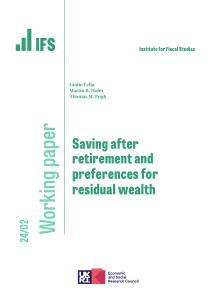How do private pensions work in the UK?
Private pension saving is a crucial part of saving for retirement in the UK. Private pension wealth makes up 42% of UK household wealth, and in 2021, £115 billion was contributed to workplace pensions by 22.6 million people and their employers.
The state pension is worth £9,654 a year in 2022–23, and so many use an income from a private pension to avoid a significant drop in their income and living standards when they retire.
Private pensions can be split into two groups: defined benefit pensions, and defined contribution pensions.
Defined benefit pensions:
- Your pension income with a defined benefit pension will depend on how many years you are a member of the arrangement and a measure of your earnings during that period.
- Employers have a responsibility to pay out this pension income for your whole life after you hit a normal pension age, and these payments increase in line with a measure of inflation, sometimes up to a cap
- You contribute a proportion of your salary, while employers contribute an additional amount depending on what is estimated to be needed
Defined contribution pensions:
- You can contribute some of your income to a defined contribution pension, and can choose how you want it to be invested
- If your employer has set up your defined contribution pension, then they will likely contribute too
- While these are mostly commonly set up through your workplace, you could also set up an arrangement with a pension provider if you are e.g. self-employed
- At retirement the size of the fund will depend on how much has been paid in and how successfully it was invested
- You can access your defined contribution pension from age 55 (it’ll be age 57 from 2028 onwards) with flexibility over how fast to draw on the pension pot through retirement
Defined benefit pensions have become less common due to private sector employers moving away from them. Overall in 1997, 46% of employees were contributing to a defined benefit pension, but this was just 28% of employees in 2021. In comparison, 51% of employees had a defined contribution pension.
The growth in defined contribution pensions was accelerated dramatically by automatic enrolment, a government policy rolled out in 2012 which requires employers to enrol most employees in a workplace pension. Workplace pension participation had been declining in the 2000s, but has now risen to around 80% of employees.
Defined benefit pensions still dominate in the public sector – 82% of public sector employees have them. Only 7% of private sector employees have a defined benefit pension.
Public sector defined benefit pensions have also been made less generous over the years through a series of reforms: in particular through increases in the normal pension age. They are, however, still much more generous than the pensions typically available in the private sector.
Defined contribution pensions provide much more flexibility over how much is contributed, how the funds are invested and how they are run down through retirement. This has lots of advantages. But it has led to concerns that many might be at risk of undersaving for retirement – not least because employers tend to contribute less to defined contribution pensions than they did to defined benefit ones.
How have pension incomes changed over time?
In the second half of the 20th century, pensioners on average had lower incomes than working-age people. A shocking over 40% of pensioners were in poverty (defined as having an income below 60% of the then median income) in the 1960s, early 1970s and late 1980s.
Recent decades have seen policy changes that have successfully targeted at tackling pensioner poverty and retirement income adequacy. As a result, pensioners are now no more likely to be in poverty than working-age people.
Successive generations of pensioners have now reached retirement with larger private pension entitlements and higher property wealth than the previous generation.
In comparison, incomes for working-age people have stagnated since the financial crisis. As a result, incomes after housing costs for pensioners have improved relative to people of working age.
Successive generations of pensioners have seen rapid increases in wealth as well as in income.
People born in the 1930s-, 1940s- and 1950s are, on average, wealthier than previous generations were at their age. This generation-on-generation growth in wealth is in part due to growing pension wealth, but also growing levels of property ownership and other financial assets from generation to generation.
But this trend has started to reverse, with no substantial generation-on-generation wealth increases for generations born from the 1960s onwards. This reflects younger generations being less likely to own property at the ages that previous generations had owned property, with this only partly offset by them being more likely to have wealth in defined contribution pensions than previous generations.
What does this mean for younger generations?
The rates of returns to different assets have declined over time, making it harder for people born later to accumulate wealth through assets. This makes it harder for them to maintain an adequate standard of living when they retire.
The returns to safe assets (like government bonds) and riskier assets (like equities) have been highest over the working lives of people born in the 1950s, and have declined since. While the house price boom in the 1990s and 2000s drove up house prices, this largely benefited those who were already homeowners by that point, and not younger generations.
People are also now living longer. Female life expectancy for those born in 1930 was 84.5 years old. This has increased to 89.9 for those born in 1985 – almost one extra year of life per decade. Male life expectancy has also increased dramatically during this period.
Now that people are living longer, they will need to do a combination of retiring later and building up more savings from pensions and other sources of wealth for their retirement. They may need more to afford care if their additional years of life are spent in poor health.
What do ‘pension freedoms’ mean for pension saving?
The ‘pension freedoms’ reforms, announced in the 2014 Budget, gave people aged 55 and over much more flexibility over how they use their defined contribution pension wealth.
Before 2015, if you had defined contribution pension wealth, you had to use it to buy an annuity, i.e. guaranteed income until death, unless you had a particularly high income from other sources or a particularly small pension pot.
After the ‘pension freedoms’ reforms, you could still purchase an annuity if you wanted, but could also choose to keep your pension pot invested and draw money from your pension at your own rate. You could do this through a structured ‘drawdown’ arrangement, using a pension pot to give you a regular income, or withdraw lump sums on an ad-hoc basis. This flexibility can have many advantages.
Pension freedoms have proved popular among pension holders. In 2020–21, 16% of people with pension pots worth £30,000 or more and accessing their pension for the first time purchased an annuity. 58% chose to move at least some of their pension into drawdown, and the remainder took some or all of their pension as a lump sum. There are concerns, however, that people may not have enough information to weigh up the costs and benefits, and understand the risks, of these different options. For example some might drawn down their pensions too fast, risking having low resources late in retirement, while others might draw on their pension too slowly and therefore unnecessarily forgo spending opportunities.









